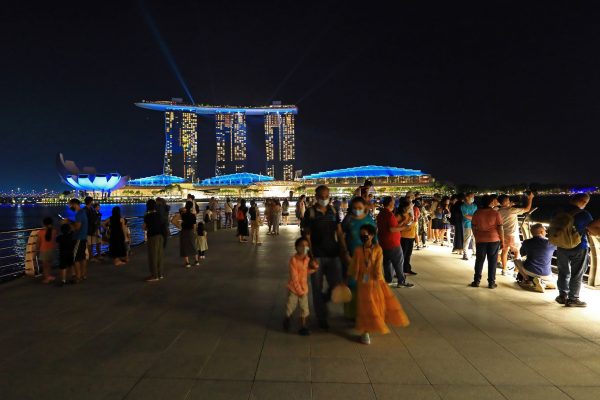Policymakers have signalled the resumption of socioeconomic activity and economic recovery as clear priorities in the annual government budget. US$17.6 billion (S$24 billion) was allocated for job creation and skills training, while another US$8 billion (S$11 billion) was allocated for the nationwide administration of vaccines and implementation of related public health measures. This included contact tracing and various subsidies and financial assistance schemes. The focus on economic recovery was further underscored by the government’s intention to borrow up to US$66 billion (S$90 billion) for infrastructure projects. US$1.9 billion (S$2.6 billion) worth of 30-year bonds was also auctioned off on 28 September 2021.
On 31 May, policymakers announced a change in Singapore’s COVID-19 management strategy. The government moved away from a zero-COVID strategy toward regular testing, identifying transmissions and encouraging vaccinations accompanied by a gradual relaxation of restrictions.
But the increase in community transmissions saw the reimposition of restrictions on dining out and other community activities from 16 May to 13 June 2021. These included transitioning to online learning in schools and cancelling the World Economic Forum’s annual meeting in Singapore. Restrictions were again reintroduced from 22 July to 18 August 2021 and from 27 September to 22 November 2021 in response to increases in community transmissions and hospitalisations.
Despite these episodes, the aggregate indicators promise an extended recovery into 2022. Various information campaigns to encourage vaccination against COVID-19 have been successful. Unvaccinated individuals without medical exemptions must bear treatment costs for COVID-19 and face more stringent access requirements to attend workplaces and various public spaces.
87 per cent of Singapore’s resident population had received a full regimen of two vaccine doses and 41 per cent had a booster by the end of 2021. Double vaccination doses will increase with the start of vaccinations for children aged 5 to 11. Since the start of the pandemic, Singapore’s resident population of 5.45 million has reported over 275,000 COVID-19 cases and over 800 deaths, with most fatalities caused by the Delta variant.
International travel to Singapore has also increased through vaccinated travel lanes (VTL). Travellers fully vaccinated with World Health Organization-approved doses are exempt from quarantine on arrival. As of 15 December 2021, VTLs for air travel with 24 countries are active. A land VTL between Singapore and Malaysia has been open since 29 November 2021.
Official estimates project Singapore’s overall economic growth to be about 7 per cent for 2021. This compares well against IMF estimates of 5.2 per cent for advanced economies and 6.4 per cent for emerging economies. Resident employment also rose in 2021 after declining in 2020. From 1 January 2022, up to half of a company’s fully vaccinated employees can resume work onsite.
But resident long-term unemployment remains elevated above pre-pandemic levels and sectoral recovery is uneven. Singapore’s prospects in 2022 will also remain dependent on the evolution of COVID-19 and the global response.
Addressing several domestic concerns are crucial to increasing popular support in the pandemic response. A recent survey reported lower public confidence in the public sector’s management of the pandemic following a surge in COVID-19 transmissions and deaths in October and November 2021. There is also continuing ambiguity about Singapore’s future leadership and concerns about a lack of diversity among ruling party decision-makers.
COVID-19’s persistence has led to signs of pandemic fatigue and increased economic hardship which is affecting social cohesion and amplifying social inequalities in Singapore. It has also reinvigorated concerns about economic insecurity, notably healthcare costs, employment and housing. These will only increase with inflationary concerns like the rise in public transport fares.
Singapore’s previous successful management of COVID-19 was due to a high level of acceptance and cooperation with policymakers. Policymakers have acknowledged a need to further engage and strengthen social trust and address economic concerns.
Reforms remain parametric at best. For example, the drafting of new legislation formalising current mediation and arbitration guidelines against workplace discrimination focuses on ensuring employment in the formal sector to manage economic insecurity and inequality.
While existing measures have helped mitigate the pandemic’s excesses, social risk pooling remains limited. Lapses in managing COVID-19 home recovery protocols and ensuring the welfare of foreign workers have only further highlighted existing structural inequalities. More substantial reforms are needed to address these structural inequalities.
Chang Yee Kwan is a Non-Resident Fellow at the Center for Southeast Asian Studies, National Chengchi University, Taipei.
This article is part of an EAF special feature series on 2021 in review and the year ahead.


What Singapore needs to do with considerable urgency is to ensure its population ceases to grow whether by immigration or natural increase. Now, of course, the latter is problematic and will take time to address (but it seems is taking care of itself ever so slowly) but the former requires immediate attention for the sake of sustainable living and the protection of what is left of its natural spaces (and that is not much).
Singapore has brought into that absurd economic model that requires eternal external pump-priming via immigration. It is particularly absurd given the size of the island upon which this so called ‘economic miracle’ is built.
It should not escape the attention of anyone that, despite this ‘miracle’ of population-fed growth, the majority of Singaporeans live in little boxes in vast numbers of high-rise buildings. By any reckoning, this is not the way to live one’s life, but that is what one gets with this kind of economic model that has been hoisted upon them.
Of course, those who gain most from this absurdity live very much more comfortably. It is always the way!
It really is time this forum put the idiocy of the population-fed economic growth model on its critical agenda. It is simply too ridiculous and destructive (of everything in the end) to be ignored … but it is!